A few weeks ago a new product jumped onto the crowd-funded scene: Backtracker. This device is essentially a radar warning system for your bike. The idea is that it can warn you of approaching cars on a LED display on your handlebars, potentially reducing the chance of an incident. This logic is driven by the fact that some 40% of bike fatalities occur with the bike being hit from behind by a vehicle.
The theory behind the system is that you might not always hear a car approach (especially fast moving ones), and in cases of bad weather, you might not always see it either (fog/etc…). Thus by using radar they can cut through both issues and display that in a minimalist way on your handlebars, increasing your awareness.
The engineering team overnighted a unit out for me to use for about 24 hours, just enough time to get in a ride and poke at the system a bit. Here’s the run-down on how it all works. Do keep in mind that everything you see is of prototype quality/finish, and that like all crowd-funded projects it depends on funding from backers to move forward.
The Components:
So let’s dive through all the components of the system, which is admittedly pretty simple.
First up you’ve got arguably the most important piece – the radar component. This portion has the ability to detect approaching traffic via radar, and then relays that to the second component to communicate to you. Additionally, as you’ll see it has a light-strip as well to warn approaching cars that you’re there.
The unit clips into a mounting system via a rail-style mount on the back. On top is a simple on/off button to turn on/off the system.
The whole thing is charged via USB, and should last about 8 hours.
Next you’ve got the display portion. This sits on your handlebars and warns you of the approaching cars.
Now these two units talk to each other using Bluetooth Low Energy. Even better is that Backtracker plans to release an API allowing Bluetooth Smart capable devices and apps to interact with the system. This means that you could directly integrate this with a cycling head unit, or even an app like Strava or Wahoo Fitness.
Like the back component, this too is charged via mini-USB and also has a rail mounting system.
Both units will then mount to this rail mounting system. Obviously these are prototype mounts that appear to be 3D-printed, thus they look a bit vintage.
Once attached, it looks sorta like this:
Speaking of attachment, let’s hook it up to the bike. Or, in my case specifically, my Dad’s bike – since I’m travelling for work out in Seattle this week. Thus, thanks Dad for letting me borrow your bike!
Installation:
Installation is about as simple as it gets. You’ve got two pieces, one goes on the seatpost, and one goes on your handlebars.
Starting with the seatpost you’ll mount the larger of the two units – the radar and rear light component.
As you can see, this just uses a simple industrial rubber band to stay on. Additionally, they’ve included a small bit of non-slip material to help keep it snuggly in place.
In case you’re curious – here’s the red light shown below. Note that intensity seen here is a bit below actual intensity since in the prototype they sent me they had reduced the brightness as they were working with them inside and were tired of getting blinded. I’m told normally they’d have adjusted the brightness upwards.
Next, we go ahead and mount the front display system. This should be mounted vertically such that the green light is at the top. You could mount it either to the handlebar, or your top tube.
Again, same industrial strength rubber band and non-slip material to keep it all in place.
Note that the units slide off the mount using a simple rail/clip system, so you can easily take them with you off the bike while leaving the mount in place.
Usage in traffic:
Next we’ll head outside. In my case, outside meant starting at 6:45AM on a miserably wet and sideways rain kinda day. No better test weather, right? Which, btw, is a good time to point out that the lights in most of these images look a little blurry. That’s simply because it was pouring out and keeping the camera lens free of rain droplets would have been no easier had I been underwater.
So let’s walk through each component step by step and how it all works. First up is the rear system that’s on the seatpost. This unit has radar capability to detect cars approaching you. It’s constantly scanning and updating, looking for approaching vehicles – such as below:
This rear unit is actually communicating to two different audiences. First is the car behind you. When it’s far away (such as 100m away), it’ll slowly blink. The closer the car gets to you, the more rapidly it blinks – thus drawing attention to you.
I was somewhat surprised in how much traffic actually slowed down in what appears to be a reaction to this. There were numerous cars that approached rather quickly, but as the blinking increased it appeared they slowed a bit.
Once a car passes, it goes back to just a steady blink.
Now, while it’s doing this, it’s also communicating information wirelessly to the little handlebar display unit. This display unit acts like a visual ‘map’ of the roadway behind you. Think of yourself in the very top spot on the light bar, where the green dot is:
As a car approaches it switches to yellow, indicating a car is approaching at normal speeds. There will be a single dot that then travels from the bottom of the light bar up to the top, depending on how far away it is. The closer the car gets to you, the closer the light gets to the top (you). For example, below it’s perhaps 75 meters away still.
Now, it’s much closer, just about to pass me.
The second the car passes by, it goes back to green and stays green until another car comes in view – which is about 150y away from you.
Now, when there’s multiple cars, it’ll actually show a single light dot for each car. For example, here you can see three cars. Two are at the top obscured by rain droplets on the camera lens, and then a third just approaching the edge of view:
Now there’s one final scenario that it’ll show – which is extremely fast moving cars. In that case it’ll blink crazy-red that a car is approaching at very high speed. I had this occur once during my ride when a car zipped by far faster than other cars. Unfortunately I didn’t have a camera on it at the time and no other cars came by as fast again. Still, it caught my attention that there was a car moving far faster than the others.
I did pick up on a couple of interesting situations. First is that the unit can actually see around bends pretty easily. For example, on this road below it curves to the right. When I came through this section going the other way, a car wasn’t directly behind me, but rather around the corner and it picked it up.
This is likely because it’s picking up a fairly wide scope of moving vehicles. For example, below I was on a short bike trail and it actually picked up the cars off to my left moving towards me.
It will correctly ignore cars going in the opposite direction. So these two cars going opposite of me weren’t on my radar map, but only the one approaching me.
So how does this all look in video format? Good, I thought you’d never ask.
Here’s a clip where I walk (err…ride) you through the different things occurring on the system. The rundown of what you’ll see:
1) First you’ll watch as a light-dot (car) slowly comes up and passes me. The car takes approximately forever to pass me. (0:00-0:13)
2) Next, you’ll see another car enter the edge of the radar range (light at bottom), I then pan back to show you how far away the car (van) is still (0:14-0:22)
3) Then, I place the camera in view to show you the blinking light, which will slowly increase as the van comes by. (0:22-0:35).
4) Right as the van passes me at the 0:35 marker, you’ll see the light reduces blinking frequency before increasing it again as more cars pass.
5) Next, around the 0:53 marker I pan back up to show you the display again as duel cars come up behind me, and then even more cars – each time you’ll see the white dots progress to the top of the display before a car appears on my left.
6) After a series of cars passes, the light finally goes green (1:20) – indicating no further cars are approaching me.
Here’s the clip:

Got all that? Good.
As you can see, it’s pretty simple.
In my hour-long ride full of traffic like this I only saw it ‘miss’ a single car on my display, which, is pretty darn impressive. I suspect it missed it because the car’s speed nearly identically matched mine, so it was sorta in no-man’s land of approaching nor not approaching.
My Thoughts:
Many of you know my thoughts on crowd-funded projects. I’m notoriously hard on companies that talk a great line, but have nothing to show for it. In the case of Backtracker though, that’s clearly not the case. They sent out a unit with nothing more than ‘give it a shot’. There were virtually no caveats other than trying to avoid heavy rain (since the prototype/test unit isn’t fully waterproofed). Despite me sorta being forced to ignore that, it worked great.
And I’ve gotta say – I came away from this morning’s ride really impressed. My route was in many ways exactly what this technology was built for. As you can see from the photos and videos it was bursts of traffic with cars flying past me. It was really cool having a bit of an extra sense that a car was approaching. It certainly doesn’t take away your responsibility for not doing something stupid – nor will it reduce every incident, but it makes you acutely aware of the traffic around you.
With that said though – I actually think the potential for incorporation of this technology far exceeds how they’re selling it today as part of the crowd-funded program. I think the real potential here is direct integration into head units. Because they offer a 3rd party API/SDK, that means that someone like Garmin could actually replicate the warning lights directly into their head unit (either on the screen, or on a separate light band). That would reduce handlebar duplication/space issues and offer incredible value.
I do wonder how much more successful they would be if they had established a few partnerships ahead of time with companies like Garmin/Polar/Wahoo/etc, and then just sold the rear radar unit, rather than complete sets. Especially when looking at products like the Garmin Touring, which is aimed more at the cross-country rider who’s more likely to want additional awareness. This also tends to include the same market of older cyclists who’s hearing might be less optimal, and thus less able to hear approaching traffic.
Looking at Backtrackers timelines of December 2014 delivery – I’d have to believe that’s fully achievable. Heck, I saw pretty much no issues on my ride today. So it would really come down to manufacturing and polish in order to hit those timelines.
With that, feel free to drop any questions down below and I’d be happy to try and get the answers to them – thanks for reading and have a great weekend!
FOUND THIS POST USEFUL? SUPPORT THE SITE!
Hopefully, you found this post useful. The website is really a labor of love, so please consider becoming a DC RAINMAKER Supporter. This gets you an ad-free experience, and access to our (mostly) bi-monthly behind-the-scenes video series of “Shed Talkin’”.
Support DCRainMaker - Shop on Amazon
Otherwise, perhaps consider using the below link if shopping on Amazon. As an Amazon Associate, I earn from qualifying purchases. It doesn’t cost you anything extra, but your purchases help support this website a lot. It could simply be buying toilet paper, or this pizza oven we use and love.

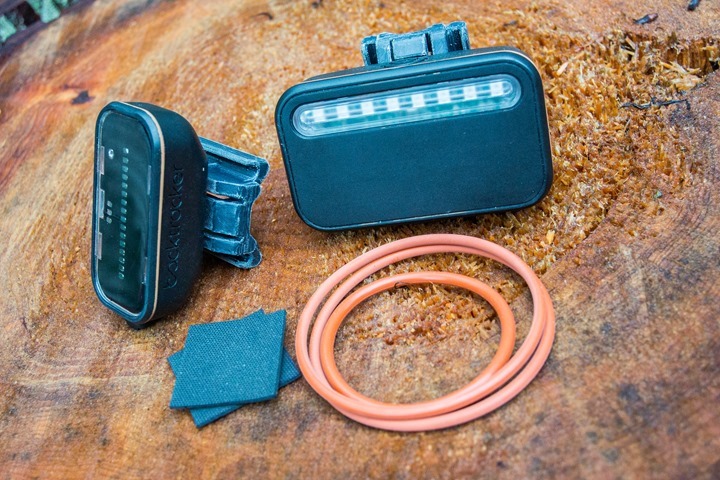
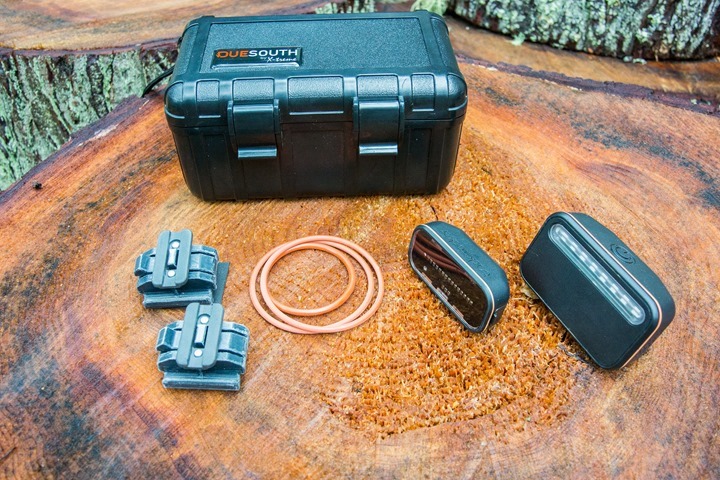
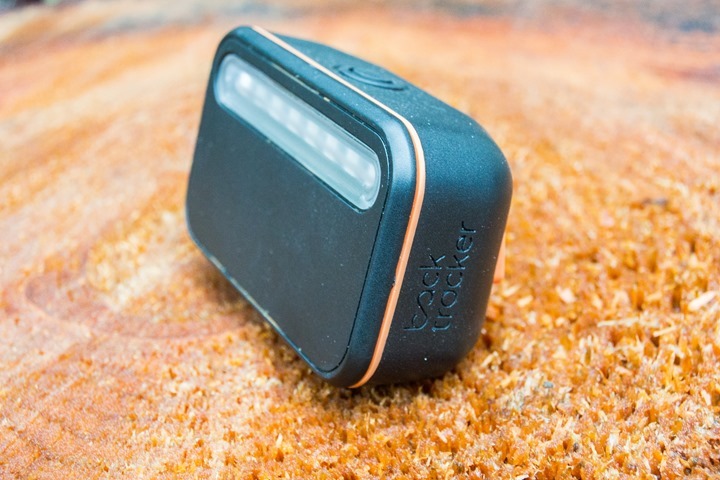
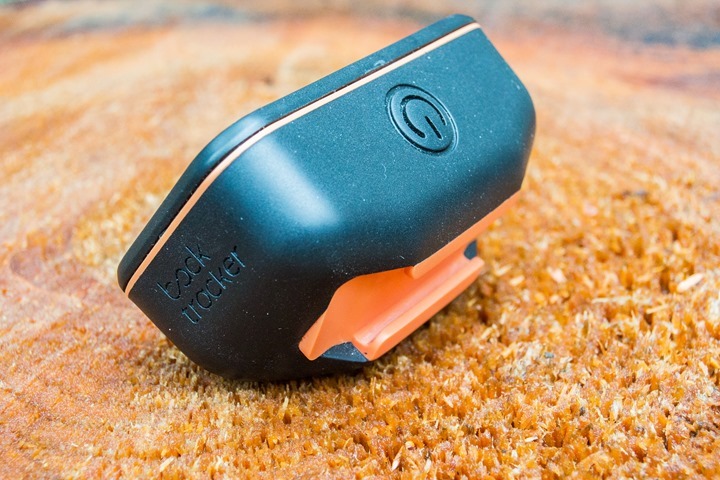
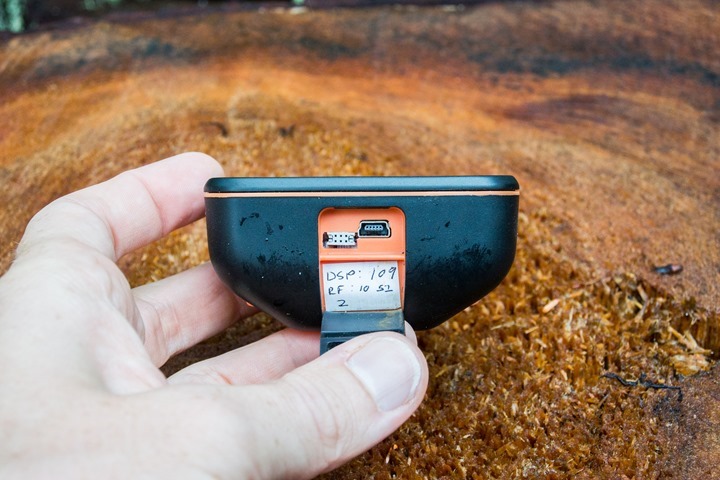
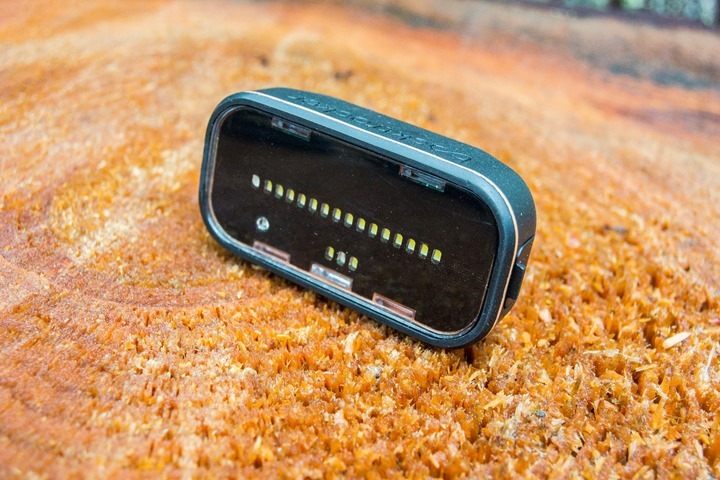
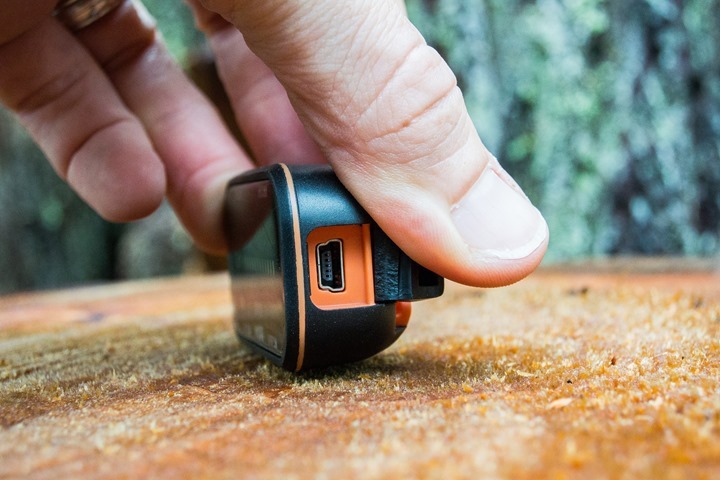
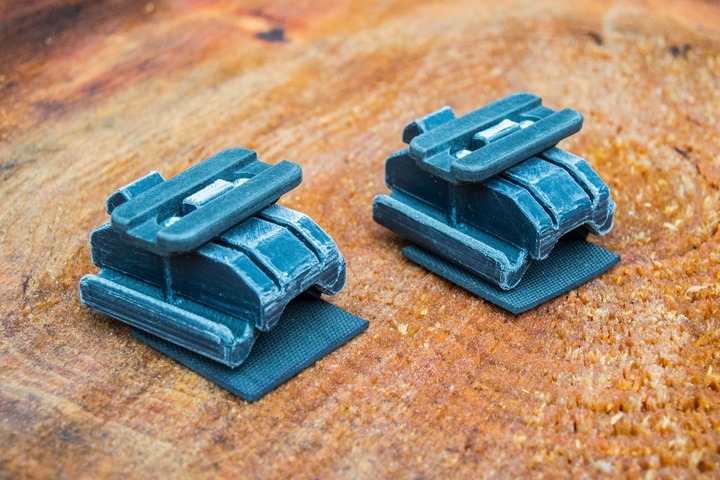
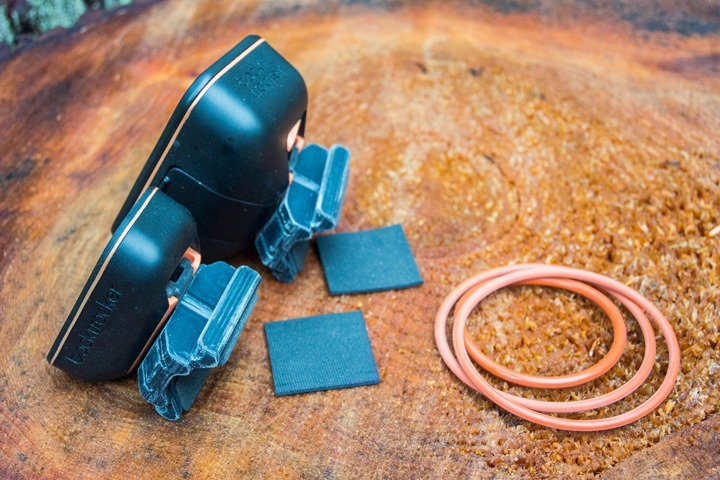
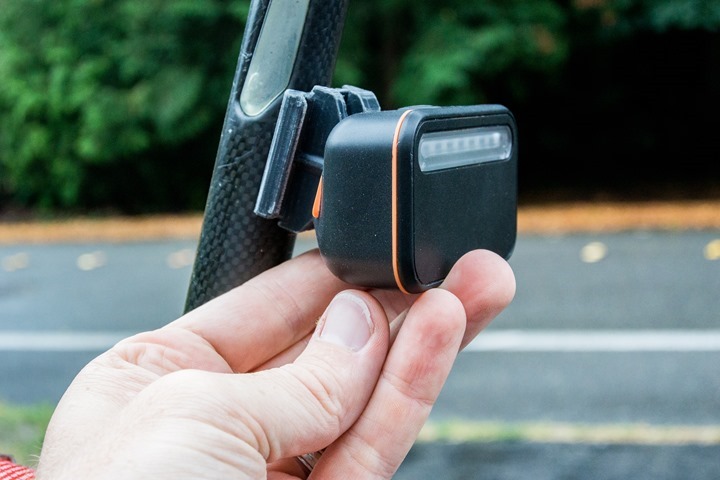
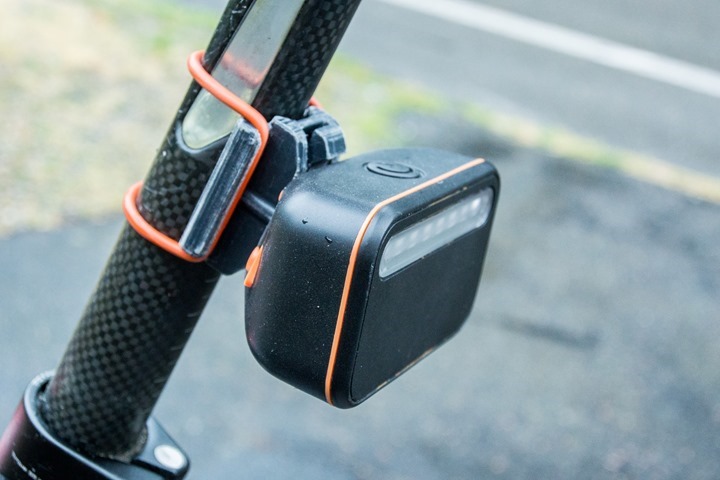
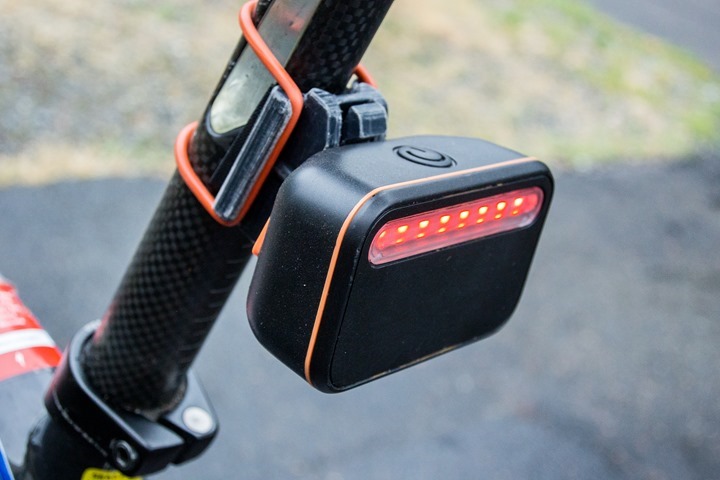

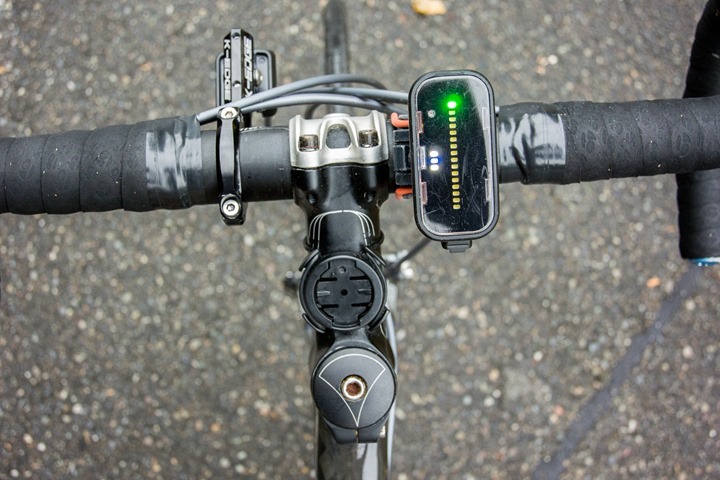



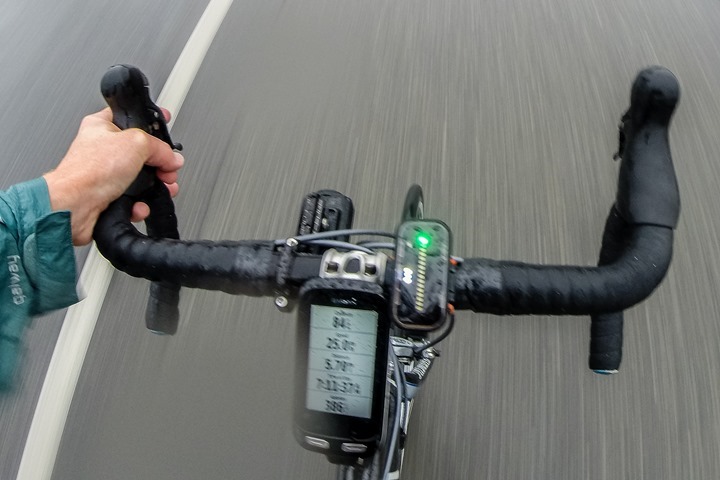
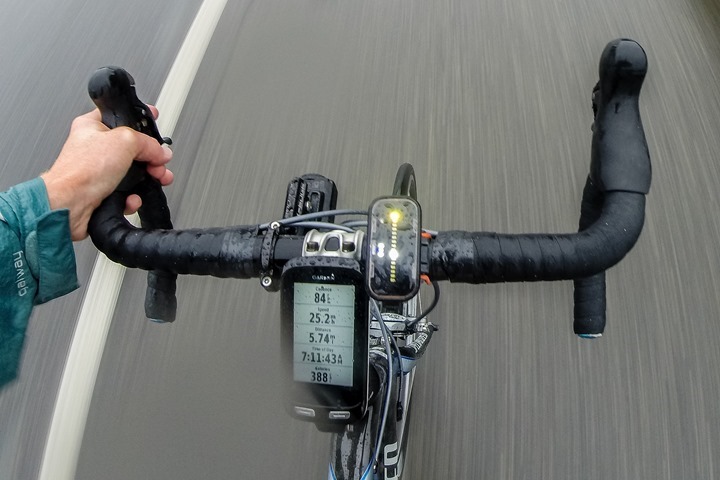
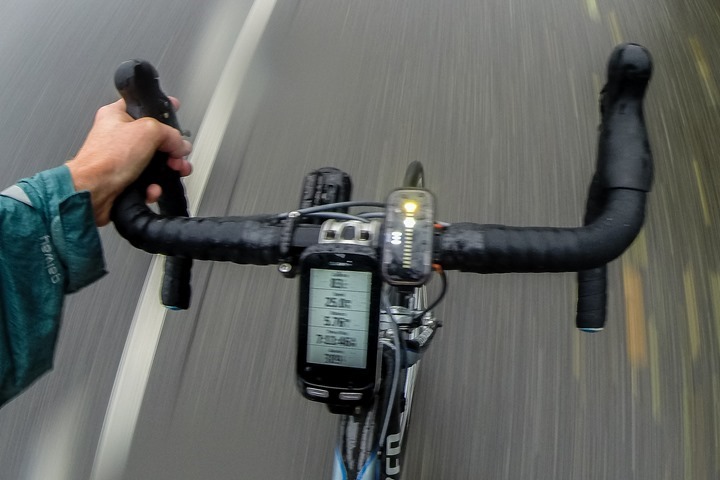

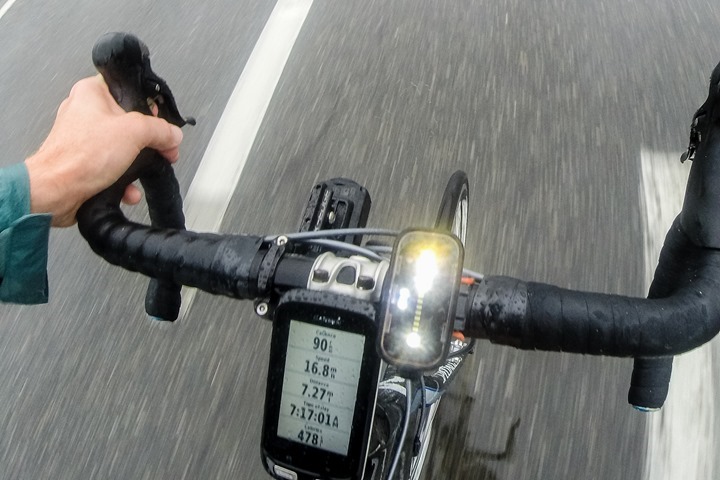
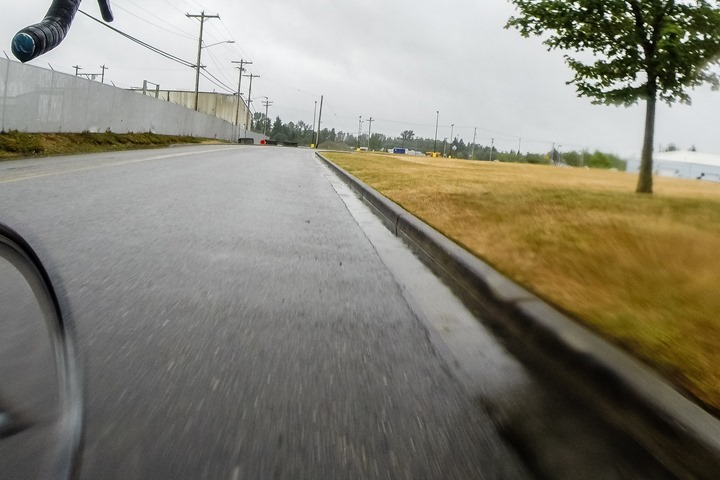
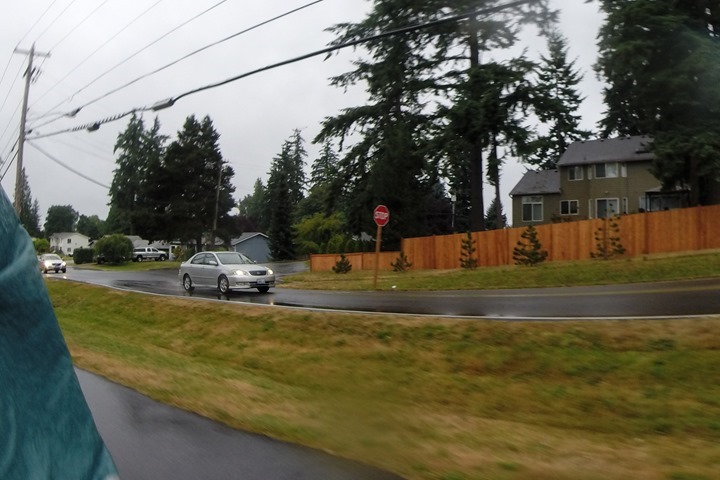

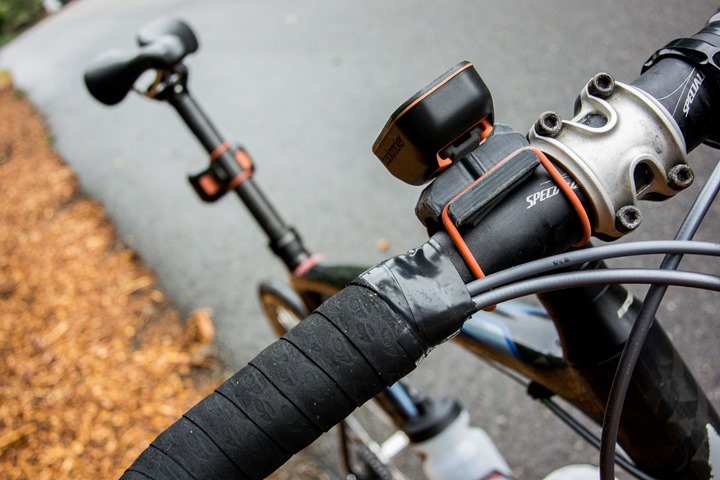
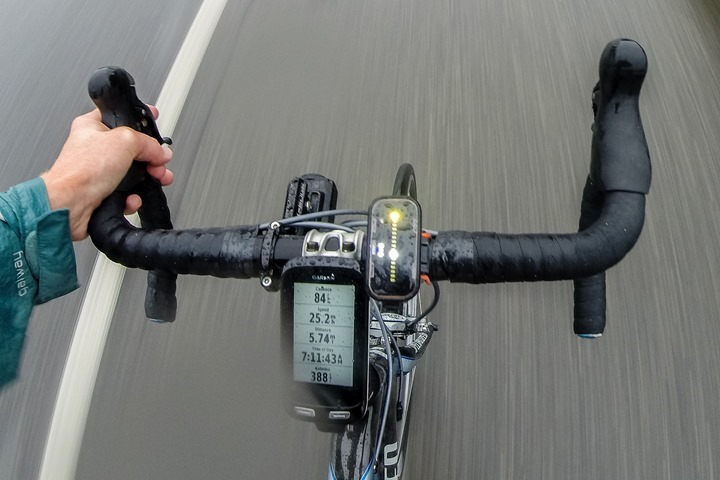
















too bad it doesn’t help with the reverse, eh.
link to twitter.com
When I first saw this I thought it looks like a solution desperately looking for a problem, and I’m not sure how much benefit the warning lights would give, especially on multi-lane roads. Given your thoughts though, at least it seems like a well engineered solution!
Are you able to see the lights in your peripheral vision? I don’t tend to spend a lot of time looking at my computer when I’m riding, so i’m a little skeptical as to how functional the head-unit would be in normal use, Integration with the 4iiii would be good though.
That said, I really like the radar-reacting light bit – I recently got a See.Sense which responds to headlights, but radar would be be a really nice addition.
Yeah, I had no issues seeing them in peripheral vision – as they’re fairly sharp/bright. Obviously in your peripheral vision you can’t quite count the number of cars, but you can clearly see that it flipped from green to yellow (or flashing red) and that something is coming.
Detecting cars is not huge, but detecting the number of cars is… and the speed as well. There is a big difference in safety to know if it’s one car coming slowly or 3 cars coming screaming by.
Nice review Rey,
Interesting one, appreciate small ideas like this people work to make biking safe.
Thanks for the review, D.C. I, too, feel this technology could be very useful to road riders. The unit caught me eye last month, and I had hoped it would be something which would not fall off the proverbial radar, so to speak.
However (and this was something I did not see in the article), does the unit have any kind of aural warning? The concept could indeed prove to be very useful as long as the user keeps their eyes glued o the display in heavy traffic. That also means your eyes are on the unit itself and not where one is going. That would be bad.
The Traffic Collision and Avoidance System (TCAS) on aircraft (also a function of Garmin’s own G1000 suite) offers an aural warning so attention can be given to the task at hand, flying, instead of constantly staring at the display.
I think an aural function would be a great addition to what looks to be a very useful tool for cyclists.
No audio warning, though, one could integrate that with an app and potentially tie it in via some other audio platform.
It’s cool that most cars will slow down when the frequency of the blinking light increases. I also wonder if this would set off radar detectors that some people use in their cars.
That’d be a bonus!
They should integrate a camera taking pictures just before a car passes. Then if you get hit there would be a way of identifying the car and driver. Kind of like a black box for accidents. If cars knew that this kind of technology was on bikes, they might be more careful.
If some of those drivers knew that bikes have the same right as them to be on the road….
When you see products coming out in 2014 that still use Mini USB (instead of Micro), don’t you just cringe?
Mini USB is far more stable than this bloody popular mirco-usb connectors. Mini USB is lasting much longer and have a solid power connection.
I would always vote for mini over micro usb.
I haven’t researched recently, but mini-USB is rated for something like 100 cycles, where micro-USB is rated for 1000 cycles. So I believe the preferred connection is micro-USB purely for that reason.
The Micro USB socket itself is more durable, but due to the locking mechanism the solder point has to be stronger than Mini USB, otherwise the failure rate is really high. I’m very careful with my devices and I’ve more than once managed to rip the entire Micro USB connector off the PC board when unplugging.
But Micro USB 3.0 is far better now because the socket is larger and soldering can be stronger.
And just to clarify for others following along…
Mini-USB is used in this product
Micro-USB is the smaller connection you’ll typically find in phones.
Photo from Google Image showing the difference: link to google.com
I had to research this myself so I could be sure.
Mini USB B (the kind used here) has a minimum durability requirement of 5000 cycles.
Micro USB has a minimum durability requirement of 10,000 cycles. (So not really that different).
BTW standard USB only requires 1500 cycles.
I found all of this information on USB.org. But it was not easy to find.
If they deliver it with a proper mount for aero-seatposts, I would buy it right away…
I’m not clear on what the rider is supposed to do with the information “car is approaching.” I guess it might be nice to know in the event you could not hear the car, but road biking requires full time defensive behavior. Personally, I ride the same whether I think a car is approaching or not.
I’m with you on this. On the roads that I ride on, there is ALWAYS a car approaching from the rear. So now that I have this information, what am I suppose to do with it? I’m already riding as far to the right as practical (presumably), now that I see a car is approaching quickly from the rear do I change my riding style? I think not.
Yep, this seems like a problem. I don’t know what I’m supposed to do with this information when the only reason I’m on the road is that I can’t get off of it (no bike lane, no safe shoulder, etc.). I can’t swerve into another lane, I can’t go fast enough to outrun a car, and I can’t swerve into a non-existent shoulder.
I don’t like the blinking light either. Changing blinking speed as the car gets closer seems like a good way to make it even harder to judge the distance of a blinking light. That results in a sort of ridiculous situation where this device improves the situational awareness of the rider who can’t avoid the accident while degrading the awareness of the one person able to prevent it.
Until yesterday, I didn’t see a need for a rearview mirror on my helmet. I would ride on the side of the road regardless of where I was.
Then I did my first 2000+ ft climb the other day with a friend. Going up is slow and steady, going down was a ton of fun. Very unpopulated smooth roads to go bombing down. My friend, who had a bike helmet mirror on, was in the middle of this mostly empty and low traffic road while I was still hugging the side, I’d see him move off to the side when a car hit his mirror, wait for it to pass then would be back in the middle of the lane again giving him the advantage of taking turns at higher speeds than I was.
This item would be PERFECT for that and would eliminate the need for a mirror hanging in your peripheral vision blinding you every time the sun hit it just right.
I would take a different approach from either you or your friend. If the road is narrow enough or lacks a suitable bike lane, I ride in the middle of the lane. If a car behind me wants to pass, they can pass me in the same safe circumstances that they could pass a car going 15mph with its hazard lights on. If there is a bike lane or the road is wide enough that I can ride safely with cars passing me in the lane, I ride on the side.
At least where I live, that behavior is all legal. As far as I can determine, that is a very safe approach. It also doesn’t require me to know whether there is a car behind me to decide what I should do.
Hi Ray,
thank’s for the great review.
A very promissing technology, indeed.
Could you ask them:
– what protocol they use for data tansmission (Ant, BT, other),
– if the 3rd party API/SDK is aimed to be used by smartphone app developers (in view of an incorporation in existing bikecomputer apps) and
– whether it would be possible to double the sensor’s use by also detecting bike speed with the aid of the Doppler effect (or in the long run even speed differences and distance between you and the car/bike behind you. Imagine taking your decisions to speed up or slow down in a bike race based on the speed difference and distance between the opponent behind you and yourself instead of having to look back and guessing constantly. I’m convinced that even the pro peleton would embrace such a technology.).
By the way, I think for touring purposes, it would be necessary to increase the battery life, as 8 hours does not seem to be enough. Of course no need for change in this respect for commuting, where the sensor would probably proof the most useful.
While this is a cool technology there’s one important thing I can’t understand from your article. How is it useful to me as a cyclist? Should I look over my shoulder every time a car approaches and try to judge if they’ve seen me? I’m thinking any contact with a car can have bad consequences. Or should I trust it enough that I should only look when a car approaches very fast? Any car in that video could have hit you without anything being different on that radar display, right? I understand that the change of the blinkrate of the rear units is good to keep drivers more alert but the front unit doesn’t make any safety sense to me yet.
Could be useful for people who travel long distances and don’t want to be killed by a truck running into them. Question is if it is more usefull then a mirror? I like the idea of the product, but not convinced yet though.
Looks interesting!
How does it respond to approaching bikes?
How about if someone drafts behind you? I’m guessing that’ll block it?
This is something I am very interested in as well! When cruising along in the zone it can sometimes be kind of startling when getting overtaken by another cyclist.
I didn’t have any other cyclists with me on my rainy ride fun. That said, the company behind it notes that while you might see some impact from other riders – that the radar tends to still pickup most cars since the radar footprint of a car is quite a bit larger than a riders frontal area. That said, it’ll of course depend on how far the rider is to you, etc…
Very very interesting gadget. They should think about version with 24h battery or HUBdynamo.
I get that these must be much, much lower powered than police radar guns, but given the health concerns surrounding police radar, and the recommendation to mount the rear unit on the seatpost, will the unit have shielding to protect the rider’s glandular tissues against microwave exposure?
I’m rather guessing that it uses radio-waves and not microwaves. The clue being in the word RADar.
Nevertheless, I’d suggest making yourself some tinfoil shorts as they would go so well with your tinfoil hat.
@EB: Microwaves are radio waves – it’s just a matter of frequency (see link to en.wikipedia.org). Police radars (in North America) use X, K, and Ka-band frequencies, which correspond to 10, 24, and 34.5 GHz and all are considered to be in the microwave band. On the other hand, domestic heating microwaves use frequencies near 2.45 MHz, smack in the middle of the popular Wi-Fi “radio” band.
I could see this product usefull on less frequent roads where you reall don’t expect many cars and as you mentioned you may not hear one apporaching. On busy roads a mirror is probably much better.!?
Agree that this has limited practical use. More useful might be a rear view heads up display. Take a look at skully motorcycle helmets
When I first heard about this device, I assumed it used some laser-based radar to not only detect approaching cars, but also to somehow calculate their trajectory, and then to offer you some sort of avoidance information, either audibly, or with an arrow blinking more and more aggressively to bail to the right (in the U.S.).
I see some very limited value for the style of riding I do; on rural highways where traffic is sparse, and there’s no paved shoulder, and a car going 65+ can suddenly surprise you.
But, a head mounted mirror likely offers similar value (for much cheaper), as both systems rely on either your constant vigilance, or peripheral vision.
The blinking tail light intensifying as car’s approach seems like a decent idea, but also likely to aggravate hateful drivers who swerve at you on purpose. (Yes, this happens with some frequency in not-bike friendly parts of the country).
But, the novelty of it could also make them think they are being video’d.
In line with several others here, I completely fail[ed] to see the purpose of this thing. But I must admit, and not the slightest bit reluctantly. that my opinions have shifted radically. First, I think that the reactive blink frequency is pure genius. Reduces annoyance for those of us who absolutely hate blinking tail lights, yet raises attention where it matters – close up. What I really thought to be ridiculous at first, is the proximity alert. But coming to think of it, this is exactly what I use my rear view mirror for on my recumbent. I never rely on it for left turns, for example, but use it exclusively to “get a feel” for the world behind me. For this, the little dashboard is absolutely brilliant, because it can be put in my line of view instead out to the side (where a mirror must be). Isn’t it amazing, how easily you can have your mind changed?!
Skully is making motorcycle helmet with a headsup display that has a rear view camera. Probably one of the best safety features I’ve seen in a long time. If that could be adapted for cycling HUD, that would be a significant advancement.
My reaction is simply: “Neat” But honestly not very useful. Great, I know there are cars. I ride with them every day. Its cool that it blinks faster as the cars approach, but the lights didn’t seem overly bright. Knowing cars are back there does not help them not run into you.
It indeed could be useful for deaf bicyclists!
Looks like a useful product. On problem I have seen with this product and reactive rear lights for bikes is attaching them to the seat post when you have a seat bag (to hold spare tube and tool) The seat bag tends to obscure the light reducing the effectiveness. Wonder if a seat bag would interfere with the radar capability.
Ray, you mentioned 40% of accidents are from the rear. Are the other 60% from head on or a combination of other bike/car poor decisions (like riding too close to a parked car and getting drilled by the driver opening a door)?
Thanks,
Carl
Here’s the breakdown: link to dragon-innovation-production.s3.amazonaws.com
It comes from the League of American Cyclists. Obviously, there are numerous places that have different metrics on how bikes vs cars tango, and clearly, those differ. How you decide to choose which one probably depends on what case you’re trying to make.
No, the League number is that 40% of *fatalities* – not crashes – are from the rear. And the folks here bring up concerns with the League’s methodology: link to iamtraffic.org
Interesting article, but it proves my point above: Everyone has some sort of fight in how they skew statistics. In this case the author had a dog in the fight around lane control. I don’t care much either way to be honest, but at the end of the day there’s a large number of people getting killed on bikes by cars, notably from behind. If that number is 31% or 40%, or even 20% – it’s still too many. I don’t think Backtracker in it’s implementation today is actually a complete solver, but I think the technology could play a part in that long term.
(As a side note, corrected language to fatality in first paragraph, thanks!)
True, he does have a dog in the fight, but that doesn’t mean that the League’s study methodology isn’t questionable compared to that of numerous prior studies on the subject. Nevertheless, as you say, the exact percentage doesn’t really matter here because we know it’s greater than zero – even one such death is one too many – and it’s Backtracker’s choice to use technology to mitigate the risk from that mode of collision. Though my concern with this and similar technology (like the Fly6) is that it can be a fine line between marketing and fear mongering to sell your product. Ultimately I think the solution is driverless cars – if we’re not all kicked off the roads by then due to those who will take the 40% number as a call to action to only let us ride only on bike paths or cycle tracks. Thanks for the review (and all your others), and thanks for making the correction to the article!
I love this idea. I don’t think the full potential of this is apparent to begin with.
I can’t wait to play with the radar API. I have several ideas I’m eager to try, including air/ground altitude sensing, robotics and, oh, cycling… :-)
“This also tends to include the same market of older cyclists who’s hearing might be less optimal, and thus less able to hear approaching traffic.”
I hope that comment wasn’t pointed at your dear “old” Dad as he was kind enough to lend you his road dampening Roubaix for the test ride :-)
Noting that I am most likely closer to your Dad’s age, and hearing is not much impaired unless listening to the wife, I would indeed make minor adjustments during a ride based on speed and density of traffic with the information provided by the device.
I previously considered rear facing cameras that display in real time to the handle bars, yet that option is impractical given glare on the display. The indicator light strip appears to be a very intuitive way of getting cues of one’s surroundings.
Motor vehicle traffic comes with riding on roads. I ride mostly 2 lane country roads without a shoulder. Knowing a vehicle is approaching from the rear is helpful, but the real issue is how close will they pass. Will I get 3′ or no space? A product that could answer this with sufficient time for a bicyclist to take action would be winner.
Is this only for solo riders? What happens if you are riding in a pack and not the last rider?
Pretty cool. I don’t see this as revolutionary but I applaud continued steps in the right direction for increasing cyclist safety. Even though there is some positive shifts for more cyclist friendly infrastructure designs all over the country. On a whole I foresee our roads and conditions getting worse over the years so we need to be planning ahead now rather then seeing a rise in cyclist accidents and deaths.
This is a promising technology that as you mentioned, has great potential as it integrates with other systems… So overall, this device gets both thumbs up from me. Will I buy it? not sure.
Also, I’d like to know how it works with other cyclists in group rides and pace lines.
Hey Ray, real quickly, the statistic at the top of the page is inaccurate and might scare folks.
“40% of bike-car accidents occur with the bike being hit from behind.”
It’s generally cited as anywhere from 3.8% to 8%, with that type of accident causing a disproportionate 40% of fatalities. Two sources which disagree (but highest estimate is 25%):
link to vox.com
link to bikede.org
Thanks for all of your fantastic writing!
“Lies, damned lies, and statistics” – Mark Twain
link to rospa.com
“In a quarter of fatal cyclist accidents, the front of the vehicle hit the rear of the bicycle.”
Good catch, of course it depends on the source and parameters of the statistics.
That said, you will note the pretty much all of the studies indicate that Helmet use is #1 and Lighting/Markers are #2 in helping to reduce bicycle injuries.
Here’s the breakdown with the 40% number: link to dragon-innovation-production.s3.amazonaws.com
It comes from the League of American Cyclists. Obviously, there are numerous places that have different metrics on how bikes vs cars tango, and clearly, those differ. How you decide to choose which one probably depends on what case you’re trying to make.
Just replied with more info on that in comment #34.
Ray,
How does this function if you are riding with a group or at least one other person? Will it detect the person riding with you and will it keep the light yellow since they are going to be behind you constantly?
If you haven’t tried this out I would be very interested to see what you find.
A rear facing light that increases blink frequency is a great idea. I think that really works well in drawing in the attention of the driver. They should consider just selling that rear light functionality. I’m still not sure I really want to be constantly aware of approaching cars–the same reason I would never mount one of those mirrors on my helmet or handlebars. It would probably just create a bunch of unnecessary anxiety while riding.
Your comments spark a thought – I too probably don’t want to know about EVERY approaching vehicle. Some logic would be great, e.g. just show me Large trucks and cars approach at a high rate of speed that are far away, or when they get close if the car is tracking to hit me (vs. moving over to give me 3ft of room) while ignoring motorcycles, slow cars, cars that are clearly moving to avoid me.
Which is why Ray’s observation of integration with head units is spot on. The feedback back would be there if you want it. My view is a little different. Not as much concerned about how to avoid a high-speed vehicle heading my way, yet it would be good to know if I can move left or right quickly when unexpected road debris and other hazards pop up in front of the bicycle (as often does in my riding). Swinging one’s head around while taking avoidance maneuvers can quickly get you into trouble – understanding of course that the device will not ensure it is safe behind you.
I’m in firm agreement, with you, Pete (#44), and Scott E (#45)!
What about this idea, instead of just a blinky that increase rate, we use the power of subliminal messaging and it blinks via morse code “Respect Cyclists, Spandex is Cool” (just kidding, not serious on that)
Hmm. Here’s a thought. Do away with the head unit, and add a LOUD audible tone and heavy duty vibration unit to the radar. The radar will continue to adjust blink rate for all cars. But, will sound the tone and vibrate when an extreme threat is sensed. such as when a vehicle approaches at a speed greater than X. This would be in lieu of the red indicator light on the head unit. But, again, not sure what I can do when I receive this information.
Also, this radar technology has been used on fleet vehicles since at least the late 80’s and is used to aid drivers when backing up.
Maybe an old-school mirror would be better, you could actually SEE!
Thanks for the write up! It’s good to hear that the technology seems pretty well developed. Imagine how expensive or inconceivable this would have been twenty years ago.
Personally, the only feature I’d be interested in is the increasing blinking intensity. I think that that sort of feedback really could help drivers be more careful.
It would be nice seeing how many cars are approaching from behind, but 99% of the time I’m not going to do anything with that information, so I wouldn’t really want the front display. If they integrated it with my head unit (Edge 810), I guess a “high speed” alert might be nice.
I would like to see more of a 2-D matrix of LEDs on the head-end to show the position of cars relative to the side of the bike, not just the rear. Particularly, if the radar unit can sense when approaching cars are within the standard 3-foot safe passing distance then it would be substantially more useful.
As the Captain of a tandem team I have for years had the benefit of a self powered and waterproof rear vehicle detection unit. On any road with a normal flow of traffic I usually tell my rear vehicle detection unit that I will always assume that there is a car approaching from behind and request notification when taking a dive off the road seems the best course of action. Her imbedded logic system estimates the speed, skill level and attentiveness of each approaching driver to determine if notification if warranted. This type of unit is quite adaptive and can use visual, auditory and tactile notification as needed.
I have found my unit especially useful when riding fast on the dark on country roads. She can scan forward and to the side for deer and other critters attempting cross our path. I highly recommend these units although they are are high maintenance items.
Neat idea and fun technology. However, I think it is completely eclipsed by a regular ol’ mirror.
Grab yourself a Third Eye helmet mirror, be able to SEE whats coming up, and then actually look at it if you want to. Without turning around.
Myself, I ride recumbent, and have two small handlebar mounted mirrors right in front of me. Sometimes feel I have better rearward vision on the bike than in my car.
Extra bonus of mirrors: they don’t need to be charged to last far, far longer than just 8 hours.
Any information regarding price? This looks like a great device.
I was mostly impressed with your ability to take video and photos single handed while riding your bike in traffic. What you really need is a drone that follows your ride and shoots the video that you need for these reviews.
Yeah, both Airdog and Hexo (both on Kickstarter recently) will do that. I’ve backed both, mostly to potentially use in cases like this. Though, that often is more work/complexity/red tape that is worth to be honest. In this case just using a GoPro trifold pole was quick and easy.
You left off “while in very wet conditions”…..
I lived in Seattle for close to 10 years, and not sure I would ride one handed in the rain while in traffic while trying to shoot a video of me from behind.
Yeah, that is either skill or guts!
I prefer to think of it as skill….
Actually, it helped that the the first half of the route was all reasonably newly paved, so there was very little to worry about pot-hole avoidance wise. But, I’ve been taking photos and video for years while riding for the blog, so I get used to it a bit.
In this case I used a GoPro mounted on one of their newfangled trifold poles, which allowed me to get a more unique video angle without the long pole to deal with (since it just folds back up again). I then had a secondary GoPro in my front pocket for taking photos.
Ray,
Did you happen to test how well it would work if you were leading with another cyclist behind you? Would the other cyclist result in spurious readings?
I think I would find it most useful when out on country roads where you might be riding side-by-side with a colleague. In those cases, I would like to know if a car is approaching from 100+ meters away so that we can return to single file quickly.
-Ivan
While I think their front display system seems to work well, I think having an open Bluetooth API would open the real potential for this product. If you could combine data from this, such as approaching speed and distance, with the video stream from devices such as Fly6, we would have a winner in reporting accidents with motor vehicles. If they added ANT+, combining their data with video would be relatively simple. If they didn’t add ANT+, surely an app like Wahoo Fitness could easily generate a GPX/TCX file with the data, if a standard rear sensor profile could be established.
Yup, it does indeed have a Bluetooth API, and I agree that it really does open up some interesting scenarios.
You might remember I was quite skeptical about this when you brought it up the first time, and I am now, like others, less so.
I still insist that they are wrong in selling this using that “cycling kills” angle, for many reasons; as pointed out before, there is not much you can do to avoid the accident. The variable blink is cute, but seriously, it’s not going to do a lot of good.
Rear-enders are most likely intoxicated drivers.
I do see however that besides being useful to hearing impaired people as previously noted, it may also benefit anyone with limited neck mobility (although I would strongly recommend to work on it, unless you have some serious condition)
I’d guess that most rear-ending – at least in the US – is due to distracted driving (cell phones, etc…). I’d guess that DUI drivers in the US taking out cyclists is actually fairly rare. In countries where distracted driving is taken more seriously (such as some in Europe), it might flip the other way.
I’m impressed, impressed enough that I just backed it.
This would be very useful on those long rides where at the end you’d be quite happy if someone hit you just so you get to stop pedalling.
Interesting and I can see how it would be useful. Ridiculously expensive though. They already exist for cars so it is not even that novel. Probably cheaper to bridge a car one onto a bike and that wouldn’t entail the risks of a crowd funded project.
Interesting military radar…would be a new market to attack if you could mount this to your motorbike aswel!Great Idea!
Great review as always, but I don’t see how this really helps you other than possibly giving you a few more seconds to contemplate life before the car hits you:-). Seriously though, after getting run off the road last year by a concrete truck, I wanted to keep a better eye on what’s going on behind me. After trying every mirror out there, and even trying the Hindsight 35 (look it up), I ended up mounting a Contour HD+ under my seat and using bluetooth to low-power stream video to my mobile that was mounted on my bike’s stem. Works great, but I still get a little anxious when one of those trucks get near me.
This would be really great for Sprinters in the TdF. Different color lights or sounds for Cavendish, sagan, Kittel, etc…
Or for those poor guys who breakaway for 120km and get caught in the last 25 meters.
As you said I think it would be better to integrate this into a existing head unit… I also agree that it should not only take high speed pictures but should add a white flash while it is doing it to let drivers know they have just had their picture taken. Just like when they run a stop that that is monitored by a traffic cam.
The possible applications for this type of device are amazing. I could see this being very usefull to motorcyclists too. I would think, however, that this would require a bit of tuning as speeds and proximity to other vehicles is a bit different. But even as it is, this could be immensely useful!!!
Nice product but useless without any kind of aural warning. If I’m not looking at the dash board I wont know a car or truck is coming behind me. Would buy it tomorrow if it was included. If not my mirrors are as good as this product and cheaper and I don’t have to charge them after a ride, just have to clean the glass from time to time.
I guess that depends on your riding posture and how you position the device. Considering the loudness of certain environments, this would have to be very loud to make a difference. It would require some kind of volume control. Personally, I think if you mount the visual part in the right place, the blinking lights will have the natural effect of attracting your attention. In fact, that is the concept behind the idea of blinking lights on the rear unit too. Our eyes have a natural attraction to pay attention to movement or blinking. That is the science behind why turn signals blink instead of just having a lit up arrow indicating directly you intend to turn.
Mirrors will actually tell you something this device will not: how close the car is going to pass you. OTOH you need to check them, the moving lights are more likely to attract your attention especially for fast approaching vehicles.
Also, there isn’t exactly a good mirror IMO for road bikes: the existing solutions are either clunky or really small and helmet mounting is not everybody’s cup (for one, I’m not always wearing one)
Any thoughts on the validity of the crowd funding platform that this is located on?
To be honest, I’ve historically not been a fan of that platform – I think it’s too tied in with the VC side of things – which means there’s less accountability there than on other platforms that have no ties to VC’s. We’ve seen that on numerous products before on the platform.
That said, in a case of not judging a book by its cover, the Backtracker guys have checked off my boxes on doing product-stuff right (read: They actually got me a real-life product to test/demo, something none of the others have been able to do). Thus, I’m less concerned about this specific project, despite the platform.
Can you mount it on the front of the bike? I can see it being very useful for detecting fast approaching trees when out mountain biking :)
forget the front end unit and just add a video cam that is radar activated and turns off after say 10s of no radar contacts. If I am going to get hit from behind there is very little I can do about it. I’d just like for there to be a record of it. Make sure its HD resolution, so the license plate and/or driver is clear.
These guys may have a natural partner in the Fly6 team. Perhaps you could hook them up.
Question: Isn’t there a known correlation between radar and cancer? Wasn’t there a big hubbub from police officers who were coming down with cancel because they kept their radar guns on their laps? Is this not a concern with having it so close to your rear end? (Colon cancer? Prostate cancer?) Has this been investigated?
With EMF a lot depends on the frequency and most importantly power of the emission and total exposure time. “Radar” is a pretty generic term, but this might help clarify a few things:
link to who.int
The radar component of Backtracker emits ~2mW, on a 30% duty cycle, while your typical cellphone emits 500mW. In order for the battery to last longer, Backtracker emits as little as possible power. The BLE part of it, emits < 1mW.
That is excellent information! Are there plans to implement something like this into other applications as suggested in the comments here? I bet this would have some amazing applications for the motorcycle community. This could even tap into a motorcycle’s electrical system eliminating the need for charging, etc.
My wife and I ride a tandem. I haven’t run the thought past her, but might there be a way to put one tail unit and two head units on our bike, so that either of us could see the radar output?
As some other respondents have already said, I think we need the lateral/sideways/2D information for this to be really useful, i.e. is the inside of the vehicle moving along a line that will have adequate clearance when it overtakes me. Maybe this is very difficult for radar to detect and might not work well on non-straight roads. The 1D information it currently provides – I mostly already have that from my ears and my rear-view mirror: both have their limitations but they work most of the time. Of course it is still valuable to emphasise this 1D information in another way, since I don’t pay constant attention to what I hear and see in the mirror.
This could be really useful on narrow windy country roads with little room for lateral manoeuvres, like the sort we have in the UK.. where approaching cars are already pretty dangerous if you though you can see them in full view, whereas for cars coming up from behind you are often reliant on just your ears which can be deceptive.
I think its important to highlight only the really important information – on the face of it, having an extra pair eyes in the back of the head, or a rear view camera like the one in the Skully motorcycle helmets, looks awesome, but I fear it would be overload.
I might still get one though the battery life is a serious drawback.
Great article and I’m going to fund this product. Here in the UK I think it would work well when I’m riding on quiet country roads with friends. With the wind in your ears I often have cars behind without realising and might be riding two abreast which is annoying for drivers. This way I know something is coming and the warning lights will alert the driver too. Agree integrating with Strava etc. Would be a bonus too, though my phone currently remains in a rear pocket.
Looks like this did not reach its funding goal. I am kind of bummed, I figured by now they would be taking pre-orders. I know of 3 cyclists killed while riding this summer. All 3 were struck from behind by cars. I feel like I feel like I need this product to remain safe on the roads. Many cyclists are moving off the roads and onto the multi-use paths. I hope Backtracker finds a way to get funding to get this product going!
I have an idea for your product that we can get it approved now. Using similar radar idea but totally different in the same sense. I like to partner with the maker of this product. Im beginning to make my idea real but i like a partner.
I have been in the vehicle tracking industry for the past 22 years and am I love cycling too. I live in South Africa and would love to market this amazing life saving product. How can I go about it?
Garmin bought them out a few months ago, and since the initial project didn’t raise enough funding to launch – it sounds like we’ll have to wait and see what Garmin does with it.
As of November 1, 2015 the device is available at Target and bike shops, on line, and other places. Around $200+. It seems like a very useful step to give human powered vehicles (and walkers) this sort of extra sensory device.
I don’t use a mirror (should, maybe, but don’t) so the radar device is welcome.
I’m not blind, but I have often wondered what gadgets like this could do for a totally blind or partially sighted person, especially in the forward moving direction. Could a sound system be offered which would simultaneously alert the user to oncoming objects of one sort or another, static objects to the side (or forward), holes, and head-level hazards?
Would this be appropriate for a deaf rider?
Is anyone aware of a radar camera system for pedestrians like there are for bikes. My father is concerned about ebikes approaching him from behind (this is on sidewalk along busy high traffic roads that has ebikes getting onto the sidewalk instead of the road. My father is elderly but very active, but his hearing is not great in regard to ebikes approaching from behind. Could the radar systems that fit on bikes be used on a person so that he could get a warning of a fast approaching ebike? Thanks for your assistance!